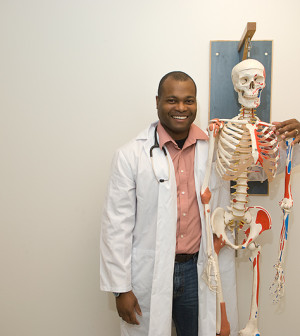- Navigating Your Midlife Crisis: Embracing New Possibilities
- City Raccoons Showing Signs of Domestication
- Mapping the Exposome: Science Broadens Focus to Environmental Disease Triggers
- One Week Less on Social Media Linked to Better Mental Health
- Your Brain Changes in Stages as You Age, Study Finds
- Some Suicide Victims Show No Typical Warning Signs, Study Finds
- ByHeart Formula Faces Lawsuits After Babies Sickened With Botulism
- Switch to Vegan Diet Could Cut Your Greenhouse Gas Emissions in Half
- Regular Bedtime Does Wonders for Blood Pressure
- Dining Alone Could Mean Worse Nutrition for Seniors
Paralyzed Man Walks Using Technology That Bypasses Spinal Cord


A paralyzed 26-year-old man has walked for the first time in five years, thanks to an electrical system that connects his brain and legs, bypassing his injured spine, researchers are reporting.
The unidentified man is the first person to show that a system like this might help people with a spinal cord injury regain some ability to walk, the researchers said.
“The work does offer exciting promise,” said Randy Trumbower, an assistant professor in the department of rehabilitation medicine at Emory University School of Medicine in Atlanta, who was not involved with the research. That said, it “must overcome several hurdles before it may be applicable to a broad population of persons with spinal cord injury,” he added.
Study authors An Do and Zoran Nenadic, both at the University of California, Irvine, said they don’t yet know how the system will work in a larger population of people with paralysis. Their report on the trial with the one candidate was published Sept. 23 in the Journal of Neuroengineering and Rehabilitation.
The experimental system is appropriate for people who have spinal cord injuries to their upper to lower-middle backs and who don’t have other major problems, Do and Nenadic said.
In their case report, Do, Nenadic, and their co-authors describe how the system worked for the 26-year-old man who had been unable to walk for five years following an injury to his upper-middle spinal cord.
Before he could try out the system, the man had to go through some muscle reconditioning to regain some strength in preparation for standing and walking.
The system required him to wear a cap with electrodes, a backpack with an amplifier, a contraption called a Parastep that electrically stimulates the legs, and a belt with a controller for the Parastep.
For each step, the system worked in a series of relayed information, beginning with the brain. When the man tried to move his legs, the signal his brain sent passed through the electrodes to the amplifier. The amplifier passed the message wirelessly to a computer. The computer analyzed the message, concluded that it said, “walk,” and passed the signal to the controller. The controller then told the Parastep to stimulate the leg to step.
In this way, the brain signal bypassed the unresponsive spinal cord, looped through the computer, and went straight to the man’s legs.
The result — he was able to walk 12 feet, his first steps since his early 20s.
With all of the components involved, the system is a little complicated. “As the authors noted, the technology is a bit cumbersome,” said Trumbower, “but it may provide a means to elicit prolonged benefit for a broad range of persons with paraplegia if controlled correctly.”
This latest system adds to a growing list of experimental options for people with a spinal cord injury. One of the other new developments, announced in July, also involves electrical stimulation with a signal that travels from electrodes on the lower back and through the spine. In one trial with this approach, five men with paralysis could move their legs in step-like movements, although they didn’t actually walk.
Another study, published in 2014, also described some success with electrical stimulation of the spine, this time with the electrodes surgically implanted. The participants could move their toes and flex their ankles and knees. One man was able to stand for a short period of time.
Nenadic and Do said they plan to test their system in more people with spinal cord injuries. “At the same time,” they said, “we are in the process of developing a simplified, more portable and more practical version.”
Spinal cord injuries above the level of the arms can result in paralysis of both the arms and the legs. Would a system like this help people with this level of paralysis?
“Indeed, I am curious to see if the technology will provide benefit for people who have more severe spinal cord trauma and who cannot use their upper extremities,” said Trumbower.
But the study authors aren’t ready to predict how it might benefit people who have paralysis in all four limbs — called quadriplegia. For these individuals, Do and Nenadic said, “the problem would be significantly more complicated as issues such as trunk and arm control would need to be addressed.”
More information
To learn more about paralysis, visit the U.S. National Institutes of Health.
Source: HealthDay
Copyright © 2025 HealthDay. All rights reserved.










